Dossier Océan et énergie - Énergie Thermique des Mers
Sommaire IOA News Letters
Deep Ocean Water cold utilization systems combined with Local Industry
By
Takenobu
Kajikawa, Shonan Institute of Technology, Fujisawa, Kanagawa 251
JAPAN
Ken Ogata, NKK Co. Ltd., Yokohama, Kanagawa 230
JAPAN
Fumihiko Kakizaki, National Institute of Science and
Technology Policy, Tokyo 100 JAPAN
Kinji Gonda, Tokai
University, Hayama, Kanagawa 240-01 JAPAN
Hamada, Kanagawa
Prefectural Museum of Natural History, Odawara, Kanagawa 250,
JAPAN
INTRODUCTION
Research and development of OTEC has been carried out for more than twenty years. Several experiments conducted onshore and offshore have served as the test or the demonstration plants (Trimble, 1980; Lorentz, 1981; Vega, 1994; Kajakawa, 1996). It can be said that OTEC technology has matured for small scale systems with a cold water pipe diameters of less than one meter.
As it seems to be difficult that the cost for an OTEC system can become remunerative in the near future, an integrated deep ocean water utilization system with a specific purpose at the special site should be considered to provide a profitable business. In this research, the core is proposed not as an integrated OTEC system, but as local industry combined with a deep ocean water utilization system. It is recognized that the coldness of deep ocean water is equivalent to more than ten times of OTEC electricity at the same flow rate. In Japan the Nansei (South-West) Islands including the Okinawa islands have many proper sites for these applications.
Our research objective is to clarify the feasibility of a commercial deep ocean water utilization system combined with a flower cultivation industry as the core local industry for Okinoerabu Island using conceptual design, cost, and profit estimations.
SYSTEM DESIGN
Design Guidelines
The local community wants to stimulate its own local industry and also use environmentally friendly renewable energy sources. The criteria of energy resources acceptable to the local community in general is as follows:
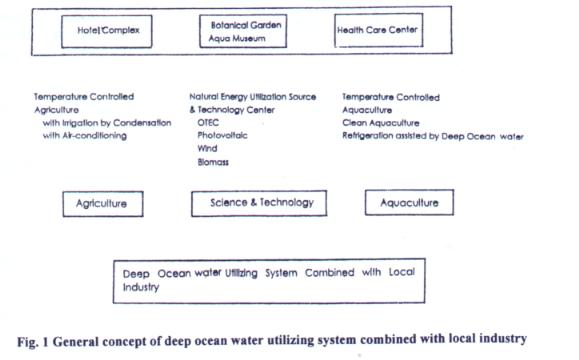
(1) The amount of energy source is plentiful within the region. It is valuable for the system to supply fresh water to the local community at the same time.
(2) The environmental impact should be small.
(3) The sources are felt to be familiar to regional people.
(4) The sources are useful to stimulate the local industry.
(5) The technology of the energy sources is mature and reliable.
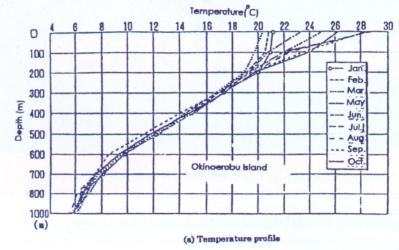
The general concept for stimulating the local industry using the deep ocean water resource is shown in Figure 1 which includes systems for agriculture, aguaculture and leisure industries.
 In consideration of promising
local industry and ease of intake of deep ocean water, Wadomari-cho, Okinoerabu
Island was selected as one of the proper local communities.
In consideration of promising
local industry and ease of intake of deep ocean water, Wadomari-cho, Okinoerabu
Island was selected as one of the proper local communities.
The major industry in Wadomari-cho is a flower cultivation industry. While the ratio of plantation area for flower cultivation to that of all agriculture is 17.9%, the revenue by the flower cultivation is 47.8% of the annual gross revenue (6.84 X 108 Yen/year). It shows that the flower cultivation is effective to increase the income.
Site Conditions
Okinoerabu Island is located N27¢X 23'26" north latitude and E128¢X 39'25" east longitude. The distance from Kagoshima-city, Kyushyu is 536km. The island often suffers from typhoons every year. The site of the cold water pipe is the north side of the island to reduce the impact of typhoons. Temperature profiles versus the water depth near the site are shown in Figure 2. The temperature of deep ocean water at 800 m in depth is 6¢XC. From this depth, the length of a cold water pipe to the land based system would be 2900 m. The outlet temperature of the cold water would be 7¢XC in consideration of heat loss along the intake pipe. The atmospheric temperature averages 22¢XC. The maximum temperature in the summer is 32.4¢XC. The minimum in the winter is 8.6¢XC.
System Design
The scale of the deep ocean water cold utilization system is determined by the production for the flower cultivatin system.
The main system is the cooling system for four flower cultivation houses, each of which has a floor area of 1000m2. Using air conditioning thetemperatures have to be kept from 25¢XC to 28¢XC during the day and between 15¢XC to 18¢XC at night during the hot summer season. The cooling load largely depends on temperature conditions. The maximum cooling load was estimated under 60% of intercept factor. At the maximum temperatures, a photovoltaic power generation system without storage battery system. Hence, the photovoltaic power generation system without storage battery system is part of this system. Three units of the wind power generation system are also included. The total load of cooling for the houses at maximum temperature conditions and at night are shown in Table 1.

Based on the above-mentioned cooling load supplied with the coldness of discharged deep ocean water from an OTEC plant, the intake flow rate of deep ocean water was estimated 412m3/h. The nominal flow rate is 600m3/h including some margin, and the warm water flow rate is 800m3/h. The inlet temperatures of the OTEC plant at the condenser and at the cooling system are 7¢XC and 10.8¢XC, respectively. The conceptual design for power distribution to the utilities of the flower cultivation system is shown in Figure3.
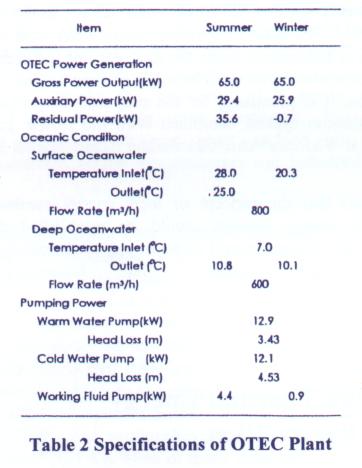
OTEC, photovoltaic, and wind power generation systems are the main power sources and a diesel engine power generation system is also provied operate the refrigeration system. The diesel engine system plays a back-up role; the existing diesel engine system on the island will be used for this purpose. The residual power generated by natural energy sources is utilized for other loads in order to reduce the consumption of oil and the environmental impact due to burning diesel. The specifications of the OTEC system are shown in Table 2. The maximum power output is 65 kW, the highest compared with past integrated OTEC systems (Brown, 1994). In winter the reduction of power output from OTEC is not serious because of the reduction of the cooling load. The auxiliary power to operate the OTEC system is 29.4 kW. In order to increase the system reliability, two sets of cold water pipes are planned to be deployed. The constituents of the cooling system using deep ocean water for 4 cooling houses is shown in Figure 4. Sixteen vertical type fan-coil units for each cooling house will supply the coldness to the flower cultivation system through cold fresh water, which is cooled using plate-type heat exchangers through which the cold deep ocean water flows. The heat duty for the plate type heat exchanger is 420,000 Kcal/h(488.4 kWt). The power needed to drive each fan is 1.25 kW. The operation mode of each unit is controlled at the central control panel to minimize the total power consumption.
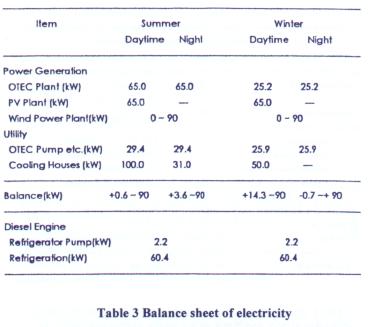
The static balance sheet of electricity is shown in Table 3. The output due to wind power will be used to reduce the consumption of diesel oil.
ECONOMIC EVALUATION
An economic evaluation has been carried out based on the baseline technology and the present market size. The resultant overall economic balance sheet is shown in Table 4.
The construction cost includes the OTEC power plant, cold water pipe, cooling house units, the chillier unit for refrigeration administration office building, photovoltaic power generation system without battery system, and three units of wind power generation systems. The operating cost includes man power cost for both power supply and bloom cultivation, maintenance cost, cultivation cost, and delivery cost (30% of the total selling). The operating cost for the bloom cultivation system is shared 96% of the total.
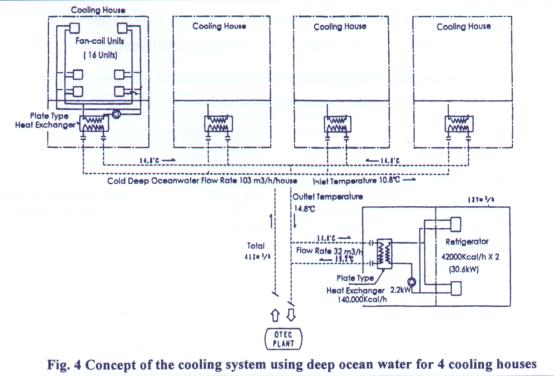
The total revenue is 1,459,655,000 Yen based on the present price of flowers and bulbs such as lily, freesia, chrysanthemum etc. The expense for the construction includes a 60% subsidy from the government and public bonds.
Finally, the profit obtained (total revenue - total expense) annually is calculated to be 177.4 Million Yen (=1,459 Million Yen - 1,281.6 Million Yen).
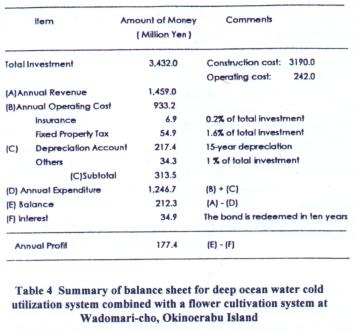
DISCUSSION AND FUTURE PROSPECTS
When conventional chilling units are used for the cooling houses, the electric power needed is 724 kW. Since the water at the site is hard, the appliances are not water-cooled but are air cooled. While the initial investment of the deep ocean water utilization system is higher than that of a conventional system by 246 Million Yen, the balance will be obtained after ten years and three months due to the low operatig cost. In the conventional system, investment of diesel power generation system, infrastructure, and countermeasure for environmental protection are not included. If these factors are considered, the proposed deep ocean water utilization system will be superior to the conventional one.
The discharged deep ocean water, after using its coldness, still has the other properties such as cleanliness and nutrient-richness. In this analysis, using the water for mariculture using these properties has not been evaluated yet. The utilization of the discharged water can possibly stimulate the local mariculture industry based on the resultant know-how in Hawaii (Daniel, 1994), Kochi (Nakashima, 1994). and Toyama.
CONCLUSION
At a first step, it is important to stimulate the local industry using deep ocean water characteristics to promote practical use of the deep ocean water resource.
A deep ocean water cold utilization system combined with a local industry such as the flower cultivation industry has been investigated. The scale of the deep ocean water cold utilization system was determined using the heat duty of the present scale of the flower cultivation system. According to the economic evaluation, it is promising for the proposed deep ocean water cold utilization system combined with the flower cultivation industry at Wadomari-cho, Okinoerabu Island, Nansei Islands in Japan.
It suggests that the concept of local energy combined with renewable energy sources should be established from the demand side. It can be said to be Supply Side management in contrast with Demand side Management.